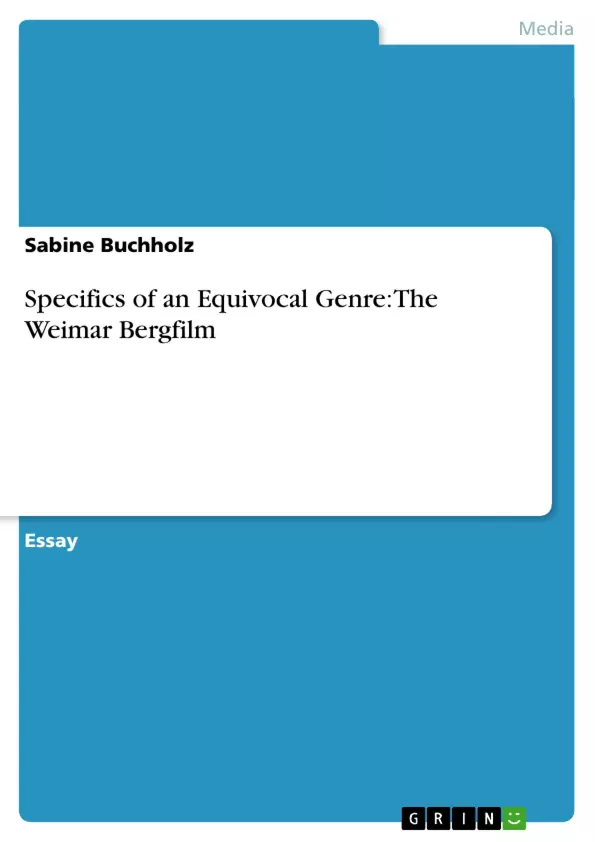Outstanding alpine landscapes, tremendous vastness, overwhelming forces of nature – these are the features of a film genre Weimar cinema has become especially famous for, and, indeed, even today is often associated with: the German Bergfilm (mountain film).
Though discussed in various studies and many essays, the mountain film still is a genre hard to define appropriately, as its particularities include a variety of ambiguities, not only concerning the question whether or not it is – as often claimed – the prototype of an anti-modernist genre supporting the National Socialist attitudes, but also with regard to the query if the mountain narratives are to be considered as the polar counterpart of the likewise popular Weimar city film.
Due to the numerous uncertainties, this essay attempts to analyze to which extent the Bergfilm contains anti-modernist elements as well as parts opposing the city film focussing especially two of the works of the most significant Bergfilm director of the 1920s, Arnold Fanck, namely “Der heilige Berg” (“The Holy Mountain”, 1926) and “Die weiße Hölle vom Pitz Palü” (“The White Hell of Pitz Palu”, 1929).
Inhaltsverzeichnis (Table of Contents)
- Specifics of an equivocal Genre: The Weimar Bergfilm
- The Bergfilm: A Genre Hard to Define
- Anti-Modernist Elements
- Modernist Elements
- The Bergfilm and the City Film
Zielsetzung und Themenschwerpunkte (Objectives and Key Themes)
This essay aims to analyze the ambiguity of the Weimar Bergfilm genre, exploring its complex relationship with modernity and its potential connection to Nazi aesthetics. By examining the works of Arnold Fanck, specifically "Der heilige Berg" and "Die weiße Hölle vom Pitz Palu", the essay investigates the genre's anti-modernist elements and its potential opposition to the city film.
- Defining the Bergfilm Genre
- Anti-Modernist Elements in the Bergfilm
- Modernist Elements in the Bergfilm
- The Bergfilm as a Counterpart to the City Film
- The Ambiguity of the Bergfilm
Zusammenfassung der Kapitel (Chapter Summaries)
- The Bergfilm: A Genre Hard to Define: This section introduces the ambiguity surrounding the definition of the Bergfilm genre and explores its diverse characteristics. It highlights the debate about its potential anti-modernist leanings and its relationship with the city film.
- Anti-Modernist Elements: This section delves into the anti-modernist elements present in the Bergfilm, focusing on the romantic imagery of nature, the use of classical artistic methods, and the glorification of heroic actions. The essay cites examples from Fanck's "Der heilige Berg" to illustrate these points.
- Modernist Elements: This section explores the modernist elements in the Bergfilm, highlighting the use of innovative filmic techniques, advancements in special effects, and psychological themes concerning the human relationship with nature. Examples from Fanck's works are used to support the argument.
- The Bergfilm and the City Film: This section compares the Bergfilm to the city film, focusing on the works of Arnold Fanck and Robert Siodmak. It explores the differences in narrative structure, aesthetic choices, and the portrayal of urban and natural settings.
Schlüsselwörter (Keywords)
This essay explores the Weimar Bergfilm genre, focusing on its ambivalent nature and its relationship to modernity and the city film. Key terms include: anti-modernism, modernism, aesthetics, nature, technology, city film, mountain film, narrative, documentary, special effects, psychological themes, and New Objectivity.
- Citar trabajo
- Sabine Buchholz (Autor), 2004, Specifics of an Equivocal Genre: The Weimar Bergfilm, Múnich, GRIN Verlag, https://www.grin.com/document/82606



